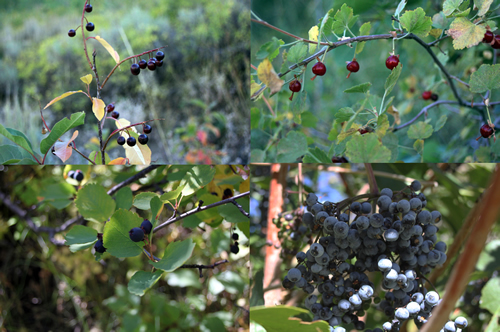
Upper left and proceeding clockwise: chokecherries, currants, elderberries and serviceberries
Fall’s Berry Crop
By Larry Hyslop

Upper left and proceeding clockwise: chokecherries, currants, elderberries and serviceberries
Fall is a tough time to hike in Thomas Canyon. It is a great time to hike but getting anywhere is difficult. Berries abound along the trail and I continually stop to sample them.
The 'royalty' of local berries has to be the chokecherry. In spring, the flowers are small and white, forming long, drooping bunches like clusters of white grapes. During good years, entire creek bottoms are white with the fragrant flowers. This year seems to be a poor year for chokecherries. The trees in Thomas Canyon Campground, usually heavy with fruit, are mostly bare this year.
The red berry contains a single, large pit. The name comes from its sour taste, but after the first frost, its tartness is delicious. Chokecherries make excellent syrup, jam and even wine.
The western golden currant produces small yellow to orange fruit with flower remains prominently displayed on the underside. Currant bushes usually grow close to a creek. The fruit is tart but can be used for jelly. The foreign fungus called “white pine blister rust” that is killing so many white bark pine trees must spend part of its life cycle in the currant bush. At one time, currant bushes were routinely destroyed in an attempt to control blister rust.
Western serviceberries bear white flowers in clumps like the chokecherry, but the flower clumps are smaller and they carry narrow, twisted flower petals. Serviceberries, or sarviceberries, flower and form berries earlier than chokecherries.
The blue or purple berries have a tuft on the end, the remains of the flower parts. While they are also delicious although bland from the bush, the several soft pits make the berries pulpy.
Elderberry flowers grow in flat faced clusters. Several large bushes line the lower Lamoille Canyon road. The berries are not good off the bush but do make pies, jellies, sauces and elderberry wine. Some people cannot tolerate a toxic substance in the berries. The hollow stems have long been fashioned into flutes and whistles.
As we enjoy fall’s berry harvest, we should remember the birds and wildlife need these berries more than we do, so leave their fair share.
Elko Daily Free Press, “Nature Notes”, 10/13/2011
© Gray Jay Press, Elko, NV
Return to Elko Nature Notes